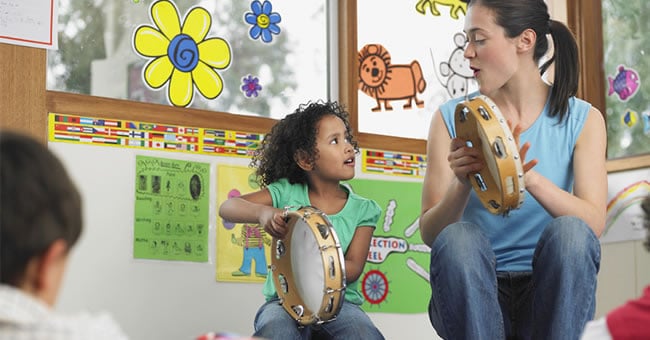
Children love music and appreciate any opportunities they have to get up and move around in the classroom, especially on cold and rainy days. Giving children the opportunity to listen to music, play instruments, experiment with sound, and move their bodies is vital in early care environments, which is why a music and movement learning center is a must-have for your preschool classroom. A music and movement center can help children develop their gross and fine motor skills, improve their balance and coordination, hone their listening skills, and learn about cultures around the world.
Taking the time to properly set up your music and movement center will help you organize a space that promotes creativity and group participation. Here are a few steps we've come up with to help you set up a music and movement learning center that fits your classroom and meets the needs of the children in your care:
1. Establish the Size and Location of Your Music & Movement Center
The size and location of your music and movement center will be determined by several factors:
- The dimensions of your classroom.
- The number of other learning centers you're including in the space.
- The number of children in your class or program.
- The number of children using the music and movement center at one time.
- The number of musical instruments and materials you plan on offering.
Remember that children will need plenty of space to play instruments and move around, so your music and movement center will need to be larger than most of the other learning centers in your classroom.
You should plan on setting up your music and movement center in a noisy area of the classroom to ensure that none of the children in the quieter learning centers are distracted or bothered. Locating the music and movement center near the dramatic play learning center would be a good idea because both tend to be noisier than other learning centers.
2. Find Furniture and Storage Solutions for the Center
The music and movement center will need to have a clear space for children to be able to safely move around, so make sure you have proper storage solutions for instruments and materials. A mobile audio pod or cart and clearly labeled storage containers are a few ways you can keep everything neat and organized.
Furniture in this area should be kept to a minimum. Use shelf storage units as a divider between centers and as a way to keep materials and storage boxes off the floor. You may also want to consider adding an area rug to define the space that children are allowed to play instruments or move and dance. A small table with a few chairs that are placed out of the way of the movement area would be another good addition to the space.
3. Provide a Variety of Musical Instruments for Children to Play
Your classroom collection of musical instruments should show diversity in sound and culture. Xylophones, bells, drums, rhythm sticks, maracas, a Chilean rainstick, and other musical instruments that represent music around the world should be included in your music and movement learning center. You can also include everyday items, such as a can of coffee beans and a box of macaroni or rice, to help kids explore sounds.
If you don't have the funds available to purchase musical instruments for kids, try making your own by filling and decorating containers with coffee beans, beads, rice, marbles, or sand. Making DIY instruments would also be a great project for kids to help with or make on their own.
4. Choose Music Tools, Materials, and Props to Include in the Space
The music tools, materials, and props you choose to include in your music and movement center all play a major role in promoting creativity and helping children develop an appreciation of music and dance. Here is a list of suggested items that can help you get kids moving and singing along to music:
Audio Visual Tools - Your music and movement learning center should have a variety of audio visual tools, such as a listening center with themed headphones, CD player, karaoke machine, or audio station. These items will help you engage kids in music and dance. You could also use audio visual tools to incorporate music into other classroom activities, including transition times and when kids clean up.
Bilingual/Spanish Materials - Music is the perfect way to introduce children to other languages and cultures. Whether it's a bilingual CD or a musical instrument that originated in another country, bilingual and Spanish materials will help encourage cultural awareness and inclusion in your classroom.
CDs for Children - Whether you're looking for classical music or popular children's songs, a wide variety of music CDs are available for your music and movement center. Your classroom music collection should be age appropriate and should include songs that encourage children to dance and sing along.
Movement & Rhythm Props - Movement and rhythm props, such as scarves or bean bags, are a great addition to your music and movement center. Scarves and other props encourage kids to get moving, work together, and creatively express themselves as they play and listen to music.
Finally:
Remember to occasionally change the materials you offer in your music and movement center to offer new experiences and help keep children interested. Check out our Music and Video section for additional items that you can use to create a learning center your preschoolers will enjoy using.
